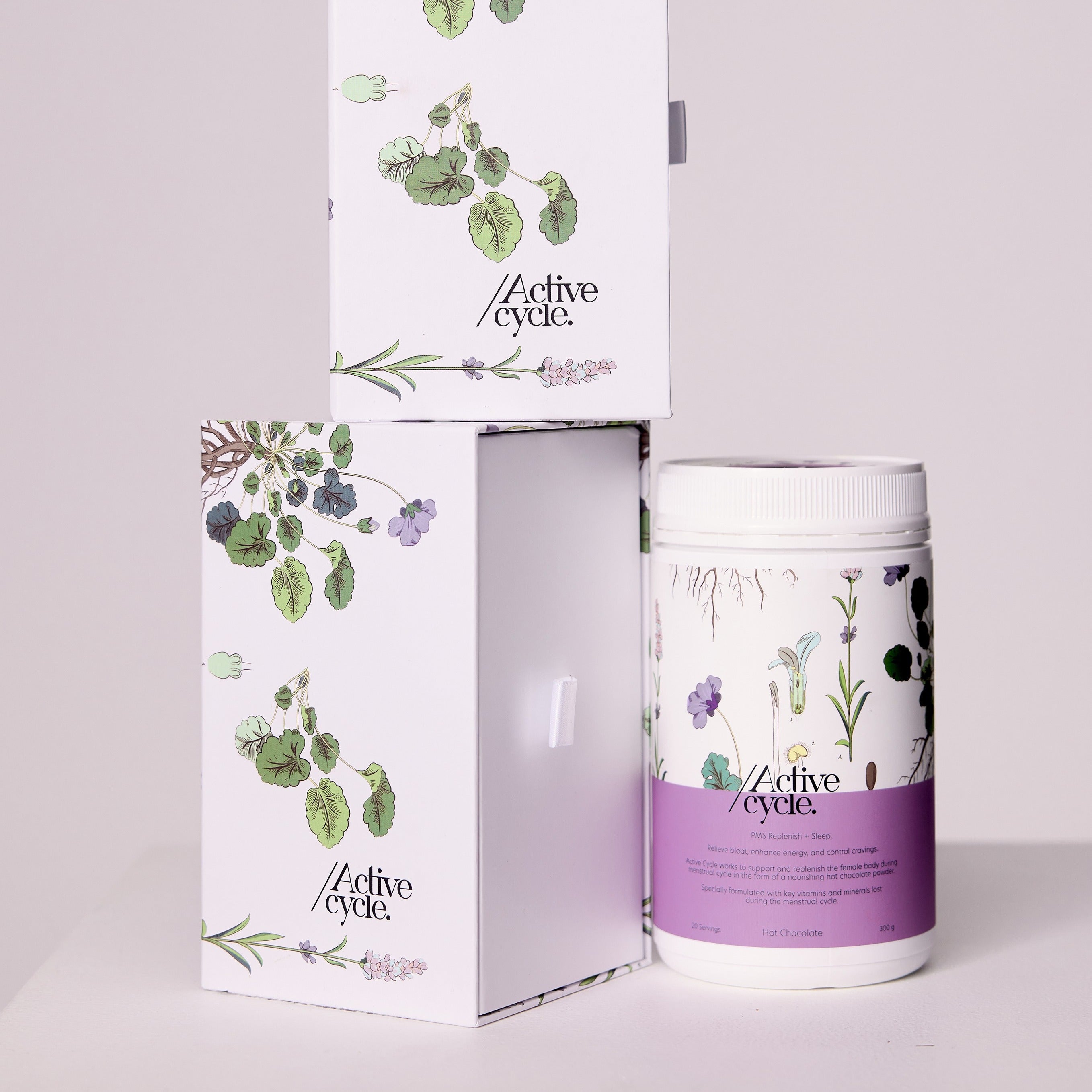The importance of vitamins and minerals goes far beyond our hair, skin and nails. They impact our physiological function in a wide range of ways, including our reproductive hormones. Hormones run a tight ship and when levels of vitamins and minerals within the body are deficient or just not quite right hormonal processes are compromised.
In women of reproductive age signs and symptoms of vitamin and mineral deficiencies can display as premenstrual syndrome (PMS), dysmenorrhea (painful periods), amenorrhea (missing period), polycystic ovarian syndrome and anovulatory cycles. All of which may benefit from correcting and supporting nutrient levels as they relate to female cyclical hormone function.
With the launch of Active Cycle, we’d like to highlight some of the key hormone supporting vitamins and minerals you can prioritise for supporting a healthy cycle and pssst….. find them in our newest product!
Vitamin B’s
The B vitamins include thiamine, niacin, riboflavin, B6, folate and B12, and they are all important! These guys are needed for the metabolism of neurotransmitters – especially serotonin (happy hormone) and GABA (calming hormone) – which when depleted are influencers in the development of PMS. Psychological symptoms like mood swings, anxiety, depression and irritability are all related to neurotransmitter health. A study on B vitamins and their influence on PMS found that women with higher intakes of riboflavin and thiamine were at lower risk of developing PMS. This can be due to depletion of riboflavin reducing serotonin metabolism and thiamine deficiencies inhibiting GABA production.
Most of the B vitamins are also involved in energy production within cells. During your cycle, energy levels can feel naturally lower and by supporting yourself with adequate B vitamins this can support your energy. Symptoms of B vitamin deficiency relating to energy include fatigue, irritability, disrupted sleep and emotional disturbances. find high levels of B vitamins in foods such as leafy greens, meats, cereals and whole grains, eggs and legumes.
Active Cycle Ingredient: Panmol Natural B Complex US100 (Organic)
Magnesium
Magnesium is the miracle mineral when it comes to female hormone health. Those that suffer from dysmenorrhea in particular may find magnesium supplementation incredibly helpful due to its naturally relaxing effect on the nervous system. Studies have shown that those with dysmenorrhea have suboptimal magnesium levels, and this may be a main driver in abnormal uterine muscle contractions – cramps – as magnesium is able to control neuromuscular contractions.
Magnesium deficiency has also been linked to stress, an inevitable feeling for many during your cycle. This becomes super clear when you consider that many of the enzymes that depend on magnesium - over 300! - are nervous system enzymes which directly link to physiological and pathological stress conditions. The good thing is that magnesium is available through both animal and plant-based sources; leafy greens, legumes, nuts and shellfish are highest in magnesium. So, getting your daily magnesium requirement is definitely possible through wholefoods.
Active Cycle Ingredient: Magnesium Amino Acid Chelate
Zinc
Zinc is certainly a powerhouse mineral. It performs an array of vital roles in the body such as building proteins, maintaining our immunity and most relevantly reproductive hormone production. Zinc deficiency in women has been proposed to result in impaired production and release of follicle-stimulating hormone (FSH) and luteinizing hormone (LH) which disrupts a regular menstrual cycle. Although, research has found that dysmenorrhea sufferers may experience reduction in the intensity of menstrual pain with increased zinc intake before and during their monthly period.
Of course, when talking about cycle health the skin can also be affected. Breakouts during and before our period are common and this is where zinc comes in. Studies have shown that those who suffer from acne have lower serum zinc levels. Oral zinc, whether that be through food or supplementation, has shown positive effects in moderate to severe acne sufferers by reducing inflammation and providing antioxidants. Regular intake of zinc rich foods such as eggs, fish, dairy, legumes and grains are a safe and easy way to boost your zinc naturally.
Active Cycle Ingredient: Guava Leaf Extract
Iron
With regular blood loss through menstrual discharge comes regular iron loss. Unfortunately, due to women’s natural predisposition to this, iron deficiency is extremely common as an average of 30-80ml of blood is lost during menses. Low energy and fatigue are major symptoms of iron deficiency in menstruating women. Iron is needed to form haemoglobin – a part of red blood cells responsible for transporting oxygen throughout the body. Essentially, if iron stores are too low haemoglobin cannot be formed causing a systemic oxygen shortage, aka that all too familiar feeling of fatigue.
The menstrual phase is definitely a time to prioritise iron rich foods to build blood and combat fatigue. There are fortunately many foods containing bioavailable iron that are highly likely to be included in daily diets - meats, fish and poultry – which are easily absorbed. However, plant sources are less bioavailable – wholegrain cereals (oats, quinoa), tofu, legumes, nuts – though iron absorption from plant sources is enhanced through pairing them with vitamin C foods, like tomatoes and citrus, or organic acids.
Active Cycle Ingredient: Ferroplant (Curry Leaf Extract) (Organic Iron)
Vitamin C
Vitamin C is well known for its role in immunity, but its functions go far beyond just that. In regard to fertility and a healthy menstrual cycle, vitamin C is definitely one vitamin you don’t want to skimp on. Vitamin C, or a form of this known as ascorbic acid, has been shown to increase serum progesterone levels in those struggling with a healthy luteal phase. Luteal phase defects are described as insufficient progesterone levels causing a weak uterine lining which can impact reaching a full-term pregnancy.
Aforementioned, vitamin C can also increase the uptake of iron. By pairing vitamin C rich foods with iron sources this can also reverse the inhibiting effect that certain substances like tea and calcium have on iron absorption. Vitamin C will have the greatest influence on meals that are predominantly plant based and only contain non-heme sources of iron as opposed to meals containing heme sources. Although, storage methods and food miles of vitamin C containing fruits and vegetables can impact the amount of vitamin C contained in our foods, so choosing fresh produce is key!
Active Cycle Ingredient: Acerola Berry Powder
Ashwagandha
Or also known as Withania somnifera, ashwagandha is a powerful adaptogenic herb. Adaptogens assist your body in its response to stress, decrease stress-induced damage and have been used in traditional medicine practices for centuries. It is the certain elements within this woody plant, such as withanolides and sitoindosides, that possess the power to protect individuals from cell damage and disease caused by stress.
Ashwagandha root is the most utilised part of the herb due to its anti-stress, anti-anxiety and sleep aiding effects. Ashwagandha directly translates to smell of horse due to smell the root emits and the common belief in Ayurveda that those who consume the adaptogen will gain the strength and vitality of a horse. And don’t we all know we need that during our period!
Active Cycle Ingredient: Ashwagandha
Milk Thistle
Milk thistle – Silybum marianum or St. Mary’s thistle – is a herb most commonly used for healthy liver function, in particular liver detoxification. Milk thistle contains an antioxidant compound called Silymarin which provides anti-inflammatory, antioxidant and antifibrotic benefits for the liver. Studies have shown that milk thistle is able to inhibit the production of COX-2, a main enzyme induced in inflammation.
How does this link to menstrual health? The liver is one of our main detoxification organs, not just of toxins such as alcohol or medications, but of our hormones too. For our hormones, like estrogen, to be metabolized and detoxified properly we need to optimize liver health. An indication of suboptimal hormone detoxification may present as symptoms of excess estrogen – heavy and/or painful periods, endometriosis, mood swings, irritability and sleep disturbances. If you can relate to any of these it may be time to start giving your liver some lovin’.
Active Cycle Ingredient: St. Mary’s Thistle Powder
Leucine & Glycine
One major factor affecting female hormone health today, and quite frankly receiving a lot of time in the spotlight for its importance, is blood sugar balance. Balancing blood sugar can be attained through particular attention to meal composition and most importantly making sure carbohydrates are eaten alongside protein and fats. If blood sugar is not balanced this can create a form of stress for the body which directly impacts hormone health. The amino acids leucine and glycine have been present in a number of studies for their effect on glucose levels. In one study, the simultaneous consumption of these two amino acids alongside glucose decreased the glucose spike by 66%.
Another common symptom of female hormone health is sleep disturbances that can occur at different stages of your cycle. Glycine also acts as an inhibitory neurotransmitter and plays a role in promoting sleep. A low dose of glycine before bedtime has seen great improvements in REM sleep quality and regulation of core body temperature in those with sleep disorders such as insomnia. A cup of Active Cycle before bed might be just what you need.
Active Cycle Ingredient: L-Glycine & L-Leucine
Fathizadeh, N., Ebrahimi, E., Valiani, M., Tavakoli, N., & Yar, M. H. (2010). Evaluating the effect of magnesium and magnesium plus vitamin B6 supplement on the severity of premenstrual syndrome. Iranian journal of nursing and midwifery research, 15 (Suppl 1), 401–405. https://www.ncbi.nlm.nih.gov/pmc/articles/PMC3208934/
Shin, H. J., Na, H. S., & Do, S. H. (2020). Magnesium and Pain. Nutrients, 12(8), 2184. https://doi.org/10.3390/nu12082184
Saei Ghare Naz, M., Kiani, Z., Rashidi Fakari, F., Ghasemi, V., Abed, M., & Ozgoli, G. (2020). The Effect of Micronutrients on Pain Management of Primary Dysmenorrhea: a Systematic Review and Meta-Analysis. Journal of caring sciences, 9(1), 47–56. https://doi.org/10.34172/jcs.2020.008
Chocano-Bedoya, P. O., Manson, J. E., Hankinson, S. E., Willett, W. C., Johnson, S. R., Chasan-Taber, L., Ronnenberg, A. G., Bigelow, C., & Bertone-Johnson, E. R. (2011). Dietary B vitamin intake and incident premenstrual syndrome. The American journal of clinical nutrition, 93(5), 1080–1086. https://doi.org/10.3945/ajcn.110.009530
National Health and Medical Research Council. (2006). Magnesium. Nutrient Reference Values. https://www.eatforhealth.gov.au/nutrient-reference-values/nutrients/magnesium
Nasiadek, M., Stragierowicz, J., Klimczak, M., & Kilanowicz, A. (2020). The Role of Zinc in Selected Female Reproductive System Disorders. Nutrients, 12(8), 2464. https://doi.org/10.3390/nu12082464
National Health and Medical Research Council. (2006). Zinc. Nutrient Reference Values. https://www.eatforhealth.gov.au/sites/default/files/2022-04/n35-zinc_0.pdf
Thiyagarajan, D. K., Basit, H., Jeanmonod, R. (2020). Physiology, Menstrual Cycle. https://www.ncbi.nlm.nih.gov/books/NBK500020/
National Health and Medical Research Council. (2006). Iron. Nutrient Reference Values. https://www.eatforhealth.gov.au/nutrient-reference-values/nutrients/iron
Tardy, A. L., Pouteau, E., Marquez, D., Yilmaz, C., & Scholey, A. (2020). Vitamins and Minerals for Energy, Fatigue and Cognition: A Narrative Review of the Biochemical and Clinical Evidence. Nutrients, 12(1), 228. https://doi.org/10.3390/nu12010228
Kennedy D. O. (2016). B Vitamins and the Brain: Mechanisms, Dose and Efficacy--A Review. Nutrients, 8(2), 68. https://doi.org/10.3390/nu8020068
Cuciureanu, M. D., & Vink, R. (2011). Magnesium and stress. In R. Vink (Eds.) et. al., Magnesium in the Central Nervous System. University of Adelaide Press. https://www.ncbi.nlm.nih.gov/books/NBK507250/
Podgórska, A., Puścion-Jakubik, A., Markiewicz-Żukowska, R., Gromkowska-Kępka, K. J., & Socha, K. (2021). Acne Vulgaris and Intake of Selected Dietary Nutrients-A Summary of Information. Healthcare (Basel, Switzerland), 9(6), 668. https://doi.org/10.3390/healthcare9060668
Roemhild, K., von Maltzahn, F., Weiskirchen, R., Knüchel, R., von Stillfried, S., & Lammers, T. (2021). Iron metabolism: pathophysiology and pharmacology. Trends in pharmacological sciences, 42(8), 640–656. https://doi.org/10.1016/j.tips.2021.05.001
Mumford, S. L., Browne, R. W., Schliep, K. C., Schmelzer, J., Plowden, T. C., Michels, K. A., Sjaarda, L. A., Zarek, S. M., Perkins, N. J., Messer, L. C., Radin, R. G., Wactawski-Wende, J., & Schisterman, E. F. (2016). Serum Antioxidants Are Associated with Serum Reproductive Hormones and Ovulation among Healthy Women. The Journal of nutrition, 146(1), 98–106. https://doi.org/10.3945/jn.115.217620
Lynch, S. R., & Cook, J. D. (1980). Interaction of vitamin C and iron. Annals of the New York Academy of Sciences, 355, 32–44. https://doi.org/10.1111/j.1749-6632.1980.tb21325.x
Chandrasekhar, K., Kapoor, J., & Anishetty, S. (2012). A prospective, randomized double-blind, placebo-controlled study of safety and efficacy of a high-concentration full-spectrum extract of ashwagandha root in reducing stress and anxiety in adults. Indian journal of psychological medicine, 34(3), 255–262. https://doi.org/10.4103/0253-7176.106022
Achufusi, T. G. O., & Patel, R. K. (2022). Milk Thistle. In StatPearls. StatPearls Publishing. https://www.ncbi.nlm.nih.gov/books/NBK541075/
Delgado, B. J., & Lopez-Ojeda, W. (2022). Estrogen. In StatPearls. StatPearls Publishing. https://pubmed.ncbi.nlm.nih.gov/30855848/
Iverson, J. F., Gannon, M. C., & Nuttall, F. Q. (2014). Interaction of ingested leucine with glycine on insulin and glucose concentrations. Journal of amino acids, 2014. https://doi.org/10.1155/2014/521941
Kawai, N., Sakai, N., Okuro, M., Karakawa, S., Tsuneyoshi, Y., Kawasaki, N., Takeda, T., Bannai, M., & Nishino, S. (2015). The sleep-promoting and hypothermic effects of glycine are mediated by NMDA receptors in the suprachiasmatic nucleus. Neuropsychopharmacology : official publication of the American College of Neuropsychopharmacology, 40(6), 1405–1416. https://doi.org/10.1038/npp.2014.326




